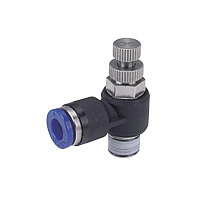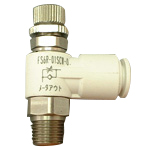(!)NOTE : Windows 7 users won’t be able to use some latest features of eCatalog/WOS since Microsoft is ending support for Windows 7 on 14 Jan, 2020. Please upgrade your system for uninterrupted services.
- Scheduled Maintenance Notice: This site will be unavailable due to scheduled maintenance from 6:30 19/1/2025 to 3:30 (IST) 20/1/2025. We apologize for the inconvenience.
- Notice of End of Sales for Economy Series Pneumatic Equipment Category. More information.
Speed Controllers(Environment, Applications:Corrosion Resistant)
Brand |
|
|---|---|
| CAD |
|
| Days to Ship |
|
2 items
- Sort By
-
You can add up to 6 items per a category to the compare list.

Corrosion Resistant Speed Controller, Corrosion Resistant SUS303-Equivalent Elbow
PISCO
Corrosion Resistant Speed Controller
Speed controllers are used to regulate the speed of movement of pneumatic actuators. They offer a wide variety of sizes to choose from.
[Feature]
● Shape : Elbow Type
● Control Type : Meter Out / Meter In
● Applicable Tube O.D. (mm.) : 4, 6, 8, 10 and 12
● Thread size : M5, R1/2, R1/4, R1/8 and R3/8
● Operating Temp. Range(°C) : 0 to 60
● Material
Body - Special Stainless Steel(corrosion resistance is equivalent to SUS303)
Seal Rubber - HNBR
[Application]
Speed controllers are installed on cylinders to adjust flow rate.Control Direction Main Body Shape Type Joint Type Material Knob Type Environment, Applications Thread Material Lock Nut Type Meter-In / Meter-Out Elbow Speed Controllers Threaded + One-Touch Fitting Stainless Steel (SUS303, SUS304) Standard Corrosion Resistant Stainless Steel (SUS303, SUS304) Ring Nut From: ₹ 2,366.11 Days to Ship: 5 Day(s) or more  5 Day(s) or more
5 Day(s) or more
-
You can add up to 6 items per a category to the compare list.

Touch Connector Five SUS Speed Controller α
CHIYODA
A speed controller made of stainless steel for improved strength and corrosion resistance.
- CAD :
- 2D
Control Direction Main Body Shape Type Joint Type Material Knob Type Environment, Applications Thread Material Lock Nut Type Meter-In / Meter-Out Elbow Speed Controllers Threaded + One-Touch Fitting - Standard Corrosion Resistant Stainless Steel (SUS303, SUS304) Ring Nut From: ₹ 2,884.73 Days to Ship: 10 Day(s) or more  10 Day(s) or more
10 Day(s) or more
| Brand |
|---|
| Product Series |
| CAD |
| From |
| Days to Ship |
| Control Direction |
| Main Body Shape |
| Type |
| Joint Type |
| Material |
| Knob Type |
| Environment, Applications |
| Thread Material |
| Lock Nut Type |
You can add up to 6 items per a category to the compare list. | You can add up to 6 items per a category to the compare list. | |
| Brand | PISCO | CHIYODA |
| Product Series | Corrosion Resistant Speed Controller, Corrosion Resistant SUS303-Equivalent Elbow | |
| CAD |
|
|
| From | ₹ 2,366.11 | ₹ 2,884.73 |
| Days to Ship | 5 Day(s) or more | 10 Day(s) or more |
| Control Direction | Meter-In / Meter-Out | Meter-In / Meter-Out |
| Main Body Shape | Elbow | Elbow |
| Type | Speed Controllers | Speed Controllers |
| Joint Type | Threaded + One-Touch Fitting | Threaded + One-Touch Fitting |
| Material | Stainless Steel (SUS303, SUS304) | - |
| Knob Type | Standard | Standard |
| Environment, Applications | Corrosion Resistant | Corrosion Resistant |
| Thread Material | Stainless Steel (SUS303, SUS304) | Stainless Steel (SUS303, SUS304) |
| Lock Nut Type | Ring Nut | Ring Nut |
Loading...
Configure
Specification/Dimensions
-
Control Direction
- Meter-In
- Meter-Out
- Meter-In, Meter-Out
- No
-
Main Body Shape
- Straight
- Elbow
- Universal
- Direct Mounting Type
-
Type
- Speed Controllers
- Throttle Valves
-
Joint Type
- Both Sides Tapped
- Threaded + One-Touch Fitting
- Both Sides One-Touch Fitting
- Others
-
Material
- Brass
- Stainless Steel (SUS303, SUS304)
- Aluminum Alloy
- Resin
-
Knob Type
-
Environment, Applications
- Standard
- Corrosion Resistant
- Clean Environment
- Sputtering Resistant
- Ozone Resistance
- Heat Resistant
- Precision Control
-
Thread Material
-
Lock Nut Type
Related Categories to Speed Controllers
-
- Cylinders, Rotary Actuators
- Cylinder Connecting Components
- Filters, Regulators, Lubricators
- Solenoid Valves
- Electromagnetic Valves
- Pneumatic Pipe Fittings
- Speed Controllers
- Silencers
- Manual-Type Valves, Mechanical-Type Valves
- Air Tube/Nylon Tube
- Fluororesin Products for Chemicals
- Pressure, Flow Rate Sensors
- Dryers
- Compressors, Blowers
- Other Pneumatic Devices
-
FAQ Speed Controllers
- Question: How does a pneumatic speed controller work?
- Answer: A pneumatic speed controller, also known as a pneumatic flow control valve or throttle valve, is a device used to control flow rate of compressed air in pneumatic systems. The operational principle of a pneumatic speed controller is when the compressed air enters the inlet of the speed controller, it encounters the needle valve. By adjusting the position of the needle, the effective size of the opening through which the air can pass is changed. If the needle is positioned to allow a larger opening, more air can flow through, increasing the speed of the actuator or the flow rate. If the needle is partially closed, less air can flow, slowing down the actuator or reducing the flow rate.
- Question: What are the types of pneumatic flow control valves?
- Answer: Here are some common types of pneumatic flow control valves
1. Speed Controller Valve : It is designed to regulate the speed of pneumatic actuators, such as cylinders and rotary actuators. It allows for controlled acceleration and deceleration of these actuators. It has 3 type consist of Meter-in, Meter-out and In-Line type
2. Needle Valve: A needle valve is a manually adjustable valve that uses a threaded stem with a tapered tip to control the flow of air. By turning the valve handle, the opening through which air flows can be adjusted, allowing for precise control of airflow and actuator speed.
3. Flow Control Valve with Check Valve: This type of valve combines a flow control valve with a check valve. The check valve allows free flow in one direction while the flow control valve regulates the flow in the opposite direction.
4. Flow Regulator Valve: Flow regulator valves automatically adjust the airflow rate based on the pressure differential across the valve. As the pressure varies, these valves maintain a relatively constant flow rate, ensuring consistent actuator speed even when the input pressure changes.
5. Flow Control Valve with Quick Exhaust: This type of valve combines flow control with a quick exhaust feature. It allows you to regulate the exhaust airflow in addition to controlling the incoming airflow. This is useful for applications that require rapid actuator retraction. - Question: Advantages of using speed controllers in pneumatic systems?
- Answer: Here are some applications of pneumatic speed controllers in industrial automation:
1. Material Handling: In automated material handling systems, pneumatic speed controllers are employed to control the movement of robotic arms, grippers, and other devices. This allows precise and controlled manipulation of objects in industries like warehousing and assembly.
2. Robotics and Automation: Pneumatic actuators are often used in robotic arms and automation systems. Pneumatic speed controllers are critical to controlling the movement of these robotic components for tasks like pick-and-place operations and assembly.
3. Printing and Labeling: In printing and labeling machines, pneumatic speed controllers help control the movement of print heads and labeling mechanisms, ensuring precise and consistent printing on various surfaces.
4. Food and Beverage Processing: Pneumatic speed controllers are used in food and beverage processing lines to regulate the speed of conveyor belts, mixers, and other equipment involved in production and packaging. - Question: Advantages of using speed controllers in pneumatic systems?
- Answer: Flow control valves find numerous applications in industrial automation, offering control over the rate of fluid flow in pneumatic systems. Here are some simplified examples:
1. Robotics: In robotic arms, flow control valves manage the speed of pneumatic actuators responsible for precise movements during tasks like picking, placing, and assembling components.
2. Packaging Machines: Flow control valves control the speed of actuators that guide packaging materials or position products, aiding in accurate and consistent packaging processes.
3. Material Handling: Automated material handling systems use flow control valves to manage the speed of actuators in processes like loading, unloading, sorting, and stacking.
4. Pick-and-Place Systems: Flow control valves regulate the movement speed of pneumatic actuators that pick items from one location and place them in another, ensuring gentle and precise handling. - Question: How to select the right speed controller for a pneumatic system?
- Answer: Essential factors need to be considered before selecting the speed controller valve
1. Proof Pressure: This information can find in a maker’s catalog for example proof pressure is 1.5 MPa.
2. Min-Max Operating Pressure: This information can find in a maker’s catalog for example proof pressure is 0.1 to 1 MPa.
3. Ambient and Fluid temperature: For example, operating temperature is 5 to 60 °C, Support Environment: Standard, Clean Circumstance, Corrosion Resistant
4. Applicable Tube material and size: For example Nylon tube outside diameter 6 mm.
5. Thread Type: Rc thread or Metric thread
6. Seal type: for example Sealant Gasket or nothing
7. Control method Meter-in, Meter-out
8. Optionals: For example, Dial scale, Lock type, and space for nameplate







How can we improve?
How can we improve?
Thank you for your time.
Your feedback is essential for our continuous improvement
Privacy Policy
Thank you for your cooperation.
Thank you for your time.
Your feedback is essential for our continuous improvement
Please use the inquiry form.
Privacy Policy